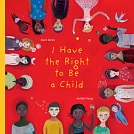
Commentaire descriptif
In plain, child-friendly language, this book outlines the rights of the child, based on the United Nations’ Convention of the same name.
Strong illustrations use rich background colours as a foundation for thoughtful compositions of objects and figures. This approach helps young readers connect with the sometimes broad and abstract concepts in the text.
Children will note that some rights they receive, and others they do not. The right to clean air, for example, may seem impossible in our time. Certain rights, such as the right “to be sheltered from disasters,” are complex.
Mature readers will be challenged by rights that are fundamental and yet unfulfilled, even in the most developed parts of the world: “enough food to eat and water to drink so that I can grow.”
The ideas, anchored in language from a child’s perspective, provide an uplifting call to action. “I have the right to be cured with the best medicines that were ever invented.”
The book’s genius lies in its universal reach: the level of discussion may be guided to suit a broad range of reader comprehension and sophistication—but discussion emerging from this book is inevitable.
|

Pistes d'exploration
: Discuss children’s rights, how they are upheld and the involvement of the United Nations. What are your responsibilities as children who have those rights?
: In small groups, illustrate the rights on cards and present them to the class, explaining what each one means. Give examples of how you use this right and how you deal with the responsibility associated with it.
: Have students make a word cloud (using a software application) for each right, using words that connect with it.
: Discuss children’s rights. Discuss how they are upheld by organizations such as the United Nations. What surprises you? What are your responsibilities as children who have those rights?
: In small groups, illustrate the rights on cards (one or two per group) and present them to the class, explaining what each one means. Give examples of how you use this right and how you deal with the responsibility associated with it.
: Discuss the consequences of each right. How does it change a child’s life when it is applied?
Mots-clés
Non-fiction, children's rights, human rights, illustrations (acrylic), peace, point of view, recurring patterns, United Nations
|


